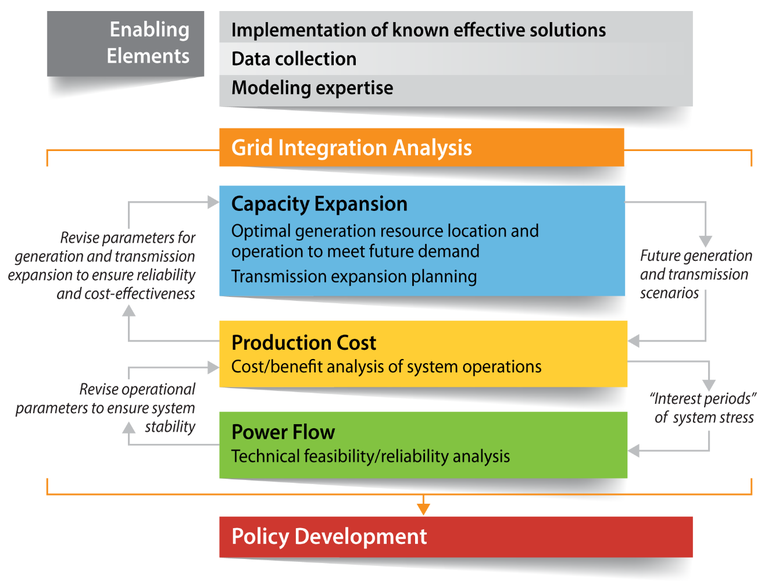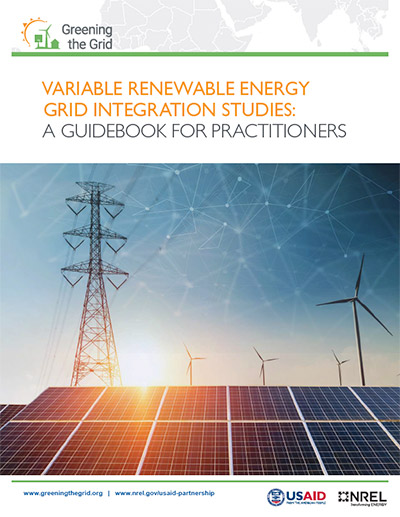Although a best-in-class grid integration study uses all three types of analyses, many studies focus on only one or two methods. The choice of which analysis or combination of analyses to implement depends on the policy-relevant questions that best address a country's priorities. Figure 1 illustrates the iterative relationship among capacity expansion, production cost, and power flow analyses, including how each type of analysis can inform the others.

Capacity Expansion Analysis
A capacity expansion analysis identifies where, when, how much, and what types of generation and/or transmission resources can provide reliable electricity supply at the least cost, considering factors such as new policies, technological advancements, fuel prices, and demand projections. Moreover, a capacity expansion analysis serves as the foundation for a power sector master plan or an integrated resource plan. Capacity expansion analyses are used to identify the appropriate type, amount, timing, and location of solar and wind generation capacity required to meet renewable energy or other policy targets. For example, a capacity expansion analysis can assess system-wide capital costs and identify cost-effective installed capacity and locations for variable renewable energy (VRE). Table 1 highlights the key attributes of a capacity expansion analysis, along with example questions that capacity expansion analyses can help to answer.
Table 1: Characteristics of a capacity expansion analysis and example questions addressed.
| Modeling Horizon |
- Medium to long-term (i.e. 20-50 years).
|
| Temporal Resolution |
- Annual for each year within the modeling horizon, with representation of seasonal and reduced-form intraday constraints.
|
| Key Inputs |
- High spatial resolution renewable energy data
- Annual electricity demand & projections
- Capital costs of generation technologies
- Fuel price projections
- Generation and transmission investment constraints
- Operational constraints.
|
| Example Applications |
- Identify cost-effective installed capacity and locations for VRE and conventional generation
- Evaluate the impacts of energy and climate policies on future system-wide costs, emissions, fuel consumption, and economic development indicators
- Identify cost-effective transmission system upgrades and expansion—including trade-offs between transmission and generation expansion
- Assess system-wide capital costs associated with one or more generation or transmission expansion plans
- Inform production cost studies by identifying and prioritizing generation and transmission buildout scenarios—including installed VRE capacity and siting
- Examine the role of various technologies, such as energy storage, in integrating VRE
- Assess long-term, system-wide trends in the decarbonization of the power sector.
|
| Example Questions Addressed |
- Where, when, how much, and what types of infrastructure would achieve VRE targets at least cost?
- How will factors such as new policies, technological advancement, and electricity demand growth affect planning for generation and transmission infrastructure in the future?
- What are the system-wide capital costs associated with different VRE targets?
- How will different VRE penetration scenarios impact economic development indicators?
- What are the expected air emissions reductions associated with various renewable energy scenarios?
- What types of generation and transmission infrastructure can protect the power sector against unexpected disruptions to normal power system operations?
|
Production Cost Analysis
A production cost analysis evaluates the effects of one or more VRE penetration scenarios on bulk power scheduling and economic dispatch, with the goal of minimizing operational costs of different future scenarios. A production cost analysis can be used to evaluate the feasibility of high renewable energy penetrations from an operational perspective and to test institutional and physical options for improving system flexibility. Note that production cost analyses do not evaluate the capital costs of new generation or transmission assets; however, capacity expansion model results can be used in production cost models. Table 2 showcases the main features of a production cost analysis, along with example questions that production cost analyses can help to answer.
Table 2. Characteristics of a production cost analysis and example questions addressed.
| Modeling Horizon |
- One future year (i.e. 10-20 years in the future).
|
| Temporal Resolution |
- Hourly to sub-hourly unit commitment or dispatch intervals.
|
| Key Inputs |
- Time-synchronous demand and renewable energy generation data
- Detailed system characteristics (i.e. generator ramping, fuel and other operational costs, transmission system attributes, and emissions restrictions).
|
| Example Applications |
- Evaluate the feasibility of high renewable energy penetrations from an operational perspective by assessing renewable energy curtailment levels, generator ramping, plant load factors, reserve requirements, reservoir and pumped storage management requirements, emissions, fuel consumption, transmission constraints, and operational costs associated with different renewable energy scenarios and flexibility options
- Test institutional and physical options for improving system flexibility to support high renewable energy penetrations, and quantify the future operational costs associated with these options
- Test the operational impacts of capacity expansion scenarios and provide feedback to help adjust capacity expansion analyses
- Identify periods of interest (such as high renewable energy/low load and/or low renewable energy/high load) that could require further stability testing through power flow analyses.
|
| Example Questions Addressed |
- What are the impacts of VRE penetration scenarios on bulk power scheduling and economic dispatch?
- What are the expected VRE curtailment levels, greenhouse gas emissions, generator ramps, plant load factors, reserve requirements, transmission constraints, and other generator-level impacts under different VRE scenarios?
- What are the relative system-wide operating impacts associated with different VRE expansion scenarios (such as different levels of VRE, siting of VRE in the best resource sites versus close to transmission lines)?
- What are the cost-effective mechanisms to access flexibility (i.e., from institutional measures such as forecasting or new infrastructure such as transmission) under high VRE penetration levels?
|
Power Flow Analysis
A power flow analysis tests the stability of the transmission system under different renewable energy penetration scenarios. A power flow analysis models real and reactive power flow, fault tolerance, and frequency response over short periods of system stress. A power flow analysis can inform system operators about mitigation measures to keep the system voltage and frequency within reliability parameters or to determine whether different renewable energy deployment scenarios meet grid code requirements. Evaluations of costs and economics are not usually components of this type of reliability analysis; however, the results from production cost analyses are used to identify periods of interest, such as coincident high renewable energy and low load or coincident low renewable energy and high load, that are evaluated in power flow studies. Table 3 outlines the key characteristics of a power flow analysis, along with example questions that power flow analyses can help to answer.
Table 3. Characteristics of a power flow analysis and example questions addressed.
| Modeling Horizon |
- Several minutes, corresponding to periods of system stress.
|
| Temporal Resolution |
|
| Key Inputs |
- Renewable energy generation profiles at discrete sites
- Details about generators’ ability to respond to contingencies, transmission line impedances, transformer details, and tap settings.
|
| Example Applications |
-
Verify the technical feasibility of high renewable energy penetrations in terms of reliability parameters, such as magnitude and duration of frequency deviation following a disturbance (including system recovery time), fault tolerance, voltage stability, network branch loading (congestion), short-circuit levels, and contingency response
-
Inform system operators about mitigation measures to keep the system voltage and frequency within reliability parameters during normal and high-stress periods
-
Serve as a reliability check for production cost scenarios
-
Determine whether different renewable energy deployment scenarios meet grid code requirements.
|
| Example Questions Addressed |
- How do high penetrations of wind and solar impact the transient stability and frequency response of the electric power system?
- Do various renewable energy scenarios meet the security or reliability criteria for the power system?
- Can the power system sustain and recover from temporary and significant disturbances and with high levels of nonsynchronous generation?
- Will various renewable energy deployment scenarios meet grid code requirements? If not, what interventions might be necessary?
- How does the power system respond to a real-time disturbance, such as an unplanned generator and/or transmission line outages, under various VRE deployment scenarios?
- What is the expected system recovery time under various VRE deployment scenarios?
|



